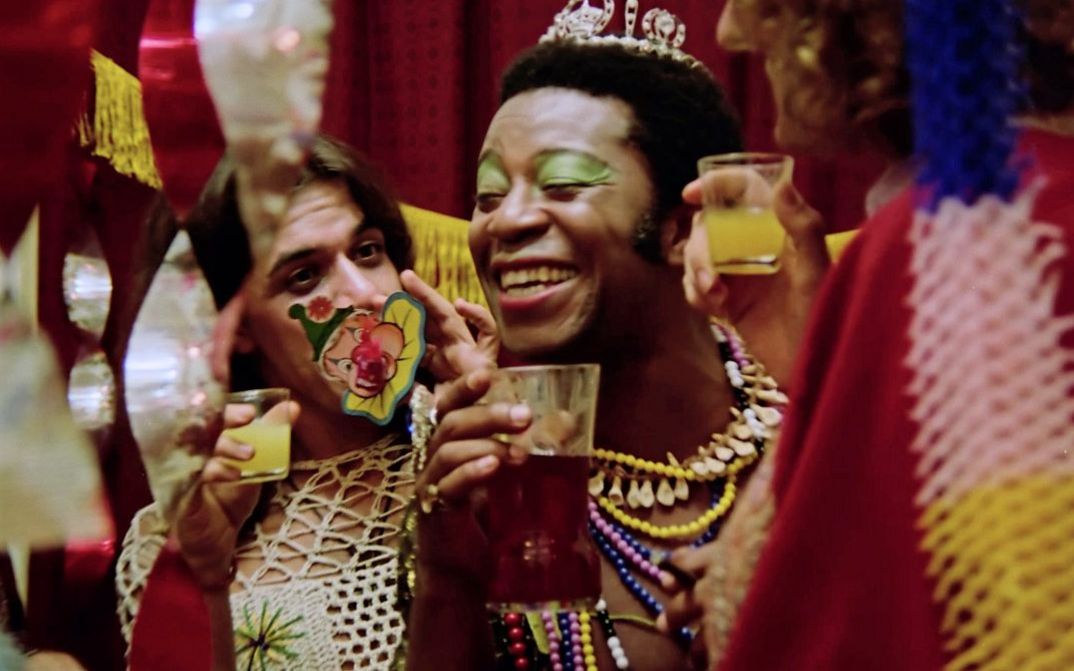A Rainha Diaba

Director
Antonio Carlos da Fontoura
Brazil / 1973
99 min.
/ Original version with English subtitles
Original language
Portuguese
The Black gay “Devil Queen” (her real name is never mentioned) rules the underworld of Rio de Janeiro from the back room of a brothel. Her eyes thick with green eyeshadow, her gaze falls mercilessly upon the members of her drug cartel. The same jackknife can be used either to shave her legs or to slit open traitors. But her reign of terror is unstable; resistance is brewing. Soon, everyone is waging war against each other to replace the queen: the favela gangsters against the gays, the drag queens against the sex workers. People with few chances in bourgeois life.
Fontoura’s garish pulp construction stands for popular Brazilian cinema during the military dictatorship, whereby power relations were exaggerated in nihilistic fashion. Much like in Karim Aïnouz’s MADAME SATÃ (2002), legendary 1930s gangster figure João Francisco dos Santos serves here as an inspiration, who this time is transposed into the 1970s as an early representation of queerness. Milton Gonçalves plays her with various voices, and the dichotomous concept of masculinity – which allows no shades of grey between macho and queen – dissolves here into glitter and air. (Jan Künemund)
Production Roberto Farias. Director Antonio Carlos da Fontoura. Written by Antonio Carlos da Fontoura. Cinematography José Medeiros. Editing Rafael Valverde. Music Guilherme Vaz. Sound design Antonio Carlos da Fontoura. Sound Alberto Vianna. Production design Angelo de Aquino. Costumes Angelo de Aquino. Make-up Carlos Prieto. Casting Emiliano Ribeiro. Assistant director Emiliano Ribeiro. Production manager Antonio Calmon. Executive producer Mauricio Nabuco. Associate producer Antonio Carlos da Fontoura. With Milton Gonçalves, Stepan Nercessian, Odete Lara, Nelson Xavier, Wilson Grey, Iara Cortes, Procopio Mariano, Lutero Luis, Carlos Prieto, Haroldo de Oliveira.
Restored by CinemaScópio and Cinelimite.
Antonio Carlos da Fontoura, born in São Paulo, Brazil in 1939, he studied geology and film. Antonio Carlos da Fontoura has written, directed and produced numerous films and television series. He has also authored two plays and a novel.
Films: 1965: Heitor dos Prazeres (13 min.). 1966: Ver Ouvir / To See, to Listen (18 min.). 1968: Copacabana Me Engana / Copacabana Is Mine (93 min.). 1970: Mutantes / The Mutants (10 min.), Meu Nome é Gal / My Mame Is Gal (10 min.). 1973: A Rainha Diaba / The Devil Queen. 1974: Chorinhos e Chorões / Chorinhos and Chorões (11 min.). 1977: Cordão De Ouro / The Golden Necklace (75 min.). 1982: Brasília, Segundo Cavalcanti / Brasilia By Cavalcanti (18 min.). 1984: Espelho de Carne / Flesh Mirror (95 min.). 1988: Uma Aventura do Zico / Zicos’ Adventure (90 min.). 2005: No Meio da Rua / The Game Boys (82 min.). 2006: Gatão de Meia Idade / Middle Age Cat (93 min.), O Rapto Das Cebolinhas / The Kidnapping Of The Chives (15 min.). 2010: Faca Sem Ponta, Galinha Sem Pé / Blunt Knife (13 min.). 2013: Somos Tão Jovens / We Are So Young (104 min.). 2015: Casa Roberto Marinho / Roberto Marinho House (18 min.). 2019: Ver Ouvir Roberto Magalhães / See Listen Roberto Magalhães (26 min.).